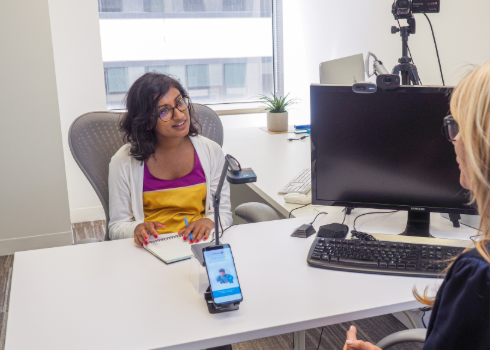Too often under-represented groups do not have great digital experiences. And why is that? Because they are often exclud...
Building Inclusivity Into Your Research Operations Practice

Posted by Sonia Jacob on Sep 30, 2019
Inclusive product development isn’t only the right thing to do, it makes business sense. Traditionally marginalized communities have more buying power than ever. If your organization ignores these groups, you could be leaving almost $490 billion on the table. Not only does inclusive design help these users, it benefits the larger community as a whole. We’ve all seen how creating a simple curb cut in a sidewalk benefits more people than just those who use wheelchairs. Now, 9 out of 10 pedestrians go out of their way to use a curb cut.
Based on our primary research, we’ve discovered people’s experiences of inclusion or exclusion influence their feelings about products and experiences in ways that design and development teams often don’t expect. Our research showed that uncovering these insights does not have to be a high-level strategic focus. Instead, inclusive design can come from grassroots efforts by baking inclusive practices into every research session. We find that many researchers value having a bigger impact on the world, and building inclusivity into research can help them create better experiences for all users. This can be done in tandem with long-term and higher level goals, making it possible for any researcher to bring this into their practice. You don’t necessarily have to conduct specialized research to get inclusive findings.
Prioritizing inclusivity both creates better experiences for your users and expands your reach in the digital world, but getting to this place requires a lot of support and intentionality at the beginning of your research process. Research operations is your fiercest ally in building inclusive practices into your research DNA from the start. Being intentional with your recruiting, scheduling, technology set-up, and other details associated with research will help you create more inclusive products. Without talking to a wide population, you risk your product leaving out people who will ultimately choose competitors who speak to them. Even if it's not the focus of the research, recruiting a diverse group of participants allows you to discover more inclusive findings. These small stories and pieces of insight from participants can open your eyes to concepts you may never have thought of.
When creating a research plan, start with these three key questions:
- Who is this experience for?
- Who might be impacted?
- Who might struggle to use this?
Your answers will help you determine who to recruit to test your experience. When talking to participants, particularly those who might struggle with your product, you should make sure they’re comfortable sharing those sentiments with you, so your organization has the information it needs to develop a better experience. In this article, we’ll walk you through the different stages of research operations and how you can incorporate inclusivity at every step of the process.
Research Ops: Your closest ally for inclusive insights
When conducting research, you can prepare the perfect research plan, a flawless prototype, and a detailed mod guide, but without the right participants, you won’t get the insights you need. This is true for standard research sessions, but is even more critical for inclusive research. At AnswerLab, our Research Operations practice manages two distinct stages of the research process: participant recruiting and session day logistics. Here are some best practices we’ve developed along the way to ensure successful and inclusive research sessions.
Recruiting the right participants
 There are a couple of ways to recruit participants to prioritize inclusivity. One way is to require a quota - for example - that at least N number of participants have certain qualities. This approach is effective if the research goal is specifically about people with these qualities. For example, if the product is meant for people with low vision, it’s important to have quotas for participants with varying levels of vision impairments. But, if using this approach for more general research, it can lead to tokenization. It’s important to note that when recruiting participants of different backgrounds, we don’t ask them to speak on behalf of people with their background. Remember to treat participants as true individuals.
There are a couple of ways to recruit participants to prioritize inclusivity. One way is to require a quota - for example - that at least N number of participants have certain qualities. This approach is effective if the research goal is specifically about people with these qualities. For example, if the product is meant for people with low vision, it’s important to have quotas for participants with varying levels of vision impairments. But, if using this approach for more general research, it can lead to tokenization. It’s important to note that when recruiting participants of different backgrounds, we don’t ask them to speak on behalf of people with their background. Remember to treat participants as true individuals.
For example, my ethnicity is Indian. I can’t speak on behalf of the majority of Indian Americans. My family speaks a different language than the majority of Indians, we have a different religion, and we even have different food. However, that’s not to say I can’t speak about my own experience of growing up with a multicultural background or that my experience wouldn’t resonate with others with similar backgrounds.
When recruiting, our approach has been to ask the questions from above to get the right mix of participants.
- Who is the experience for?
- Who might be impacted?
- Who might struggle to use this?
Attempt to hypothesize the answers to these questions. Then recruit based on those answers to validate your hypotheses. By framing a recruiting screener this way, you’ll also ensure that your findings will directly impact product decisions and provide your stakeholders with a way of concretely implementing inclusivity.
Preparing your participants for research
Finding the right participants is half the battle for ensuring the right recruit. But, the next step is getting your participants prepared and comfortable before they even walk in the door. You want them to come into your research sessions with an impression that their questions and concerns will be taken seriously and that it’s a safe space for them to share their true feelings. Some best practices include: (1) including guidance to the building where they’ll be testing; (2) providing copies of any helpful documentation ahead of time, such as NDAs or instructions; and (3) determining whether participants need additional assistance.
Getting to the research session
Providing an address is not enough! It’s important to share information about the building more generally as well. Is there free parking? Is an alternative mode of transportation available? Is the building accessible? Are there wheelchair ramps? If these questions are not answered before research sessions, participants could be frazzled or rushed, and you may end up using some of your precious time relaxing participants before jumping in to the research.
Creating easy and transparent participant agreements

We have participants review a research agreement and NDA before sessions so that they’re aware of what the experience will entail. We usually have participants sign the document at the research site. But with remote sessions, we always ask they print and sign the document before the research. We discovered that printing the agreements can be a hardship for people who don’t have access to a printer or are low income. Printing and mailing costs can often get in the way.
On the flip side, having participants view the agreement for the first time at the research site can also be problematic. They may not be aware that the session will be recorded, for example, which can make them feel nervous or skeptical of how their information will be used. We’ve developed a hybrid solution for these issues. The first is to provide participants with a copy of the agreement ahead of time to review. Then, we have them sign the agreement at the research site. Another option (especially for remote sessions) is to use an online signature tool, such as DocuSign. We also suggest including a short summary of the document using non-legal terminology. Often, participants feel they’re signing over all their privacy to be involved and this is a great way to ease their concerns.
In Australia, for example, participants were much more reticent of signing our agreements because they felt too detailed and invasive. We ended up modifying the agreement itself to provide a blurb that expressed the content we were capturing would be used for research purposes only. By giving participants this extra reassurance, they felt more comfortable with the information they were providing.
Understanding if they need assistance
Our recruiting partners communicate with participants to ensure they have everything they need for session days. This conversation before sessions allows us to tailor best practices to welcome a wide variety of participants. It’s good to ask participants directly for what they need. For example, if a participant is transgender, it’s ok to ask what pronouns they prefer ahead of time. This is also a good time to ask if they need any assistance getting into the building or if they have a caretaker or service animal that might be accompanying them. Creating a space for conversation, even in email form, allows participants to feel like they can share their experience and honest feedback during sessions.
The in-person experience
 Making a good first impression
Making a good first impression
When participants come to in-person research sessions, we like to create an inviting space as they wait for sessions to start. This means having a receptionist available to answer questions, sharing WiFi information, and providing water or light snacks. Other participants may require additional assistance. For example, in a recent study, I worked with children and their caregivers. Because the caregivers were often busy parents who needed to bring their other children along, we had a babysitter on-site to watch over the other kids in a calm, quiet space away from the lobby area if needed.
Curating a comfortable lab space
Consider the overall experience of your lab space for both the participant and the product being tested. For example, if you’re testing a mobile device, what are some options that are not only optimal for recording, but are also comfortable for the participant holding the device? How will the moderator and the participant interact with each other? Are they going to be face to face? Will they be sitting down? If participants need anything to assist them, such as screen readers for people who are vision impaired, we recommend asking them to bring the devices to the center. This way they can focus their experience on your product, not assistive products. We’ll also provide translators or interpreters if necessary, or offer them the option to bring someone they already know if they prefer.
Ensuring a successful tech set-up
One of the benefits of conducting onsite research is that you and your organization can control the technology and environment to help you capture the right information. To do this and accommodate participants, it’s important to test out the tech setup in the room. For example, if your participant is in a wheelchair, they may need an adjustable desk. You may need cameras that move or are easily adjustable to adequately capture their responses to certain stimuli.
Build rapport throughout the research
Consciously work to make your participant feel comfortable in your space. To do this, we recommend building in time to build rapport at the start of the session. Other ways to accomplish this could include providing (unbiased) examples of information you’re looking for as a prompt or building in short breaks, especially if participants have cognitive limitations that make concentrating for long periods of time difficult. If you’re looking for other ways to up-level your moderating skills, check out the AnswerLab UX Research Moderator’s Rubric.
When I was working with teens with cognitive disabilities, I made sure to keep my moderator guide flexible. I had a few key points I had to touch on, but otherwise tried to keep the stimuli light. We also had a small quiet space available for participants if they became anxious or needed a break. This was incredibly beneficial for one participant who needed a break in the middle of the session. When she and her caretaker came back, we discussed some of her coping tools for emotional regulation. While we ended up only using 30 minutes of our hour-long time slot, our clients found value in hearing her discuss coping methods, and more importantly, our participant left with a smile and excitement over the product she tested.
Meeting people where they are: Remote and in-home research
Most of the advice and examples we’ve provided are based on one-on-one interview sessions where participants come onsite. However, one of the exciting things about UX research is that there are a number of other contexts and methodologies you can use, and they all have their benefits. Sometimes, in context research at a participant’s home or work can provide a deeper look into how users interact with your product in their everyday lives.
Remote research, on the other hand, allows you to connect with users across the country or the world who you wouldn’t be able to speak with otherwise. By expanding your reach through remote sessions, you’ll be able to talk to people from all walks of life, in different geographies, with different backgrounds who can help round out your understanding of your users and your products in various contexts.
Ethnographies or in-homes
In-home testing can be a logistical nightmare but is very valuable for conducting exploratory, generative research. In-homes help teams gain empathy for their users and build better products that meet the user where they are.
This is especially true for organizations who want to understand how accessible their products are. Conducting research in people’s homes lets you see users’ tech and space setup and their preferences for accessibility tools. If a participant uses a screen reader or other assistive technology at home, it can be invaluable to go and witness what that’s like in their own space. On the other hand, you’ll never have the same level of control as you do in your lab, so it can be tricky to capture and record the session for later use. Here at AnswerLab, we’ve created a lightweight mobile lab kit that allows us to capture the information we need despite issues with the space or WiFi connection.
 Remote research
Remote research
We conduct remote research to allow participants to speak to us in the comfort of their own home without us having to go to them. This is a cost-effective way to reach participants across the country or the world in their own space without having to go to each location. The variety of participants can help provide insights into unifying themes and call out new insights based on an individual’s deeper context. And because they’re at home, you don’t have to worry about creating a warm, welcoming space in the same way.
However, because remote sessions often require video conferencing tools that have a heavy bandwidth, populations that are not as tech-savvy may have trouble participating in your research. Of course, there are certain requirements they must meet to participate: a stable WiFi connection and access to a computer, tablet, or mobile device depending on the project. However, there are a few ways you can help ensure their experience joining a session is as smooth as possible. For example, try creating a “cheat sheet” with steps for how to join the video conference or have a recruiter call them 5-10 minutes before the session to walk them through the technology and troubleshoot issues that arise. We recommend doing remote sessions in tandem with in-person sessions to get a comprehensive understanding of your user base.
If you’re specifically targeting non-tech savvy users or those who may not be able to afford the necessary technology to participate in remote interviews, you may want to choose another method like in-home interviews, in-lab research, or even a phone interview in some cases.
...
Incorporating inclusivity into your research operations practice is a great first step for incorporating inclusivity organization-wide. It helps show rather than tell the experiences of a wide population that many of your stakeholders may not have previously considered. Incorporating the feedback from these participants will help your organization start having conversations about inclusivity and what you represent as an organization. These guidelines are a starting point for you, for us, the UX community, and our clients. But, this is an ongoing process and as technology evolves, it will be even more important to continue refining this framework to accommodate all of your users.
Just starting on your inclusivity journey? Check out our article on defining inclusivity and building team alignment to create more inclusive experiences.
Sonia Jacob
Sonia Jacob, a member of our AnswerLab Alumni, was a UX researcher during her time at AnswerLab where she led research to help fortune 500 brands create experiences people love. Sonia led AnswerLab's 2019 original research efforts exploring inclusivity in product design. Sonia may not work with us any longer, but we'll always consider her an AnswerLabber at heart!related insights
Get the insights newsletter
Unlock business growth with insights from our monthly newsletter. Join an exclusive community of UX, CX, and Product leaders who leverage actionable resources to create impactful brand experiences.